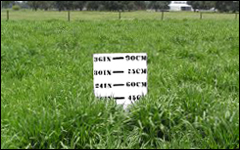- Return to Article Of The Month index
Mulato (Brachiaria sp.)
May 2008
Dr. Joao Vendramini - Range Cattle Research & Education Center
Brachiariagrasses, including Mulato, are tropical warm-season forages native to Africa. Brachiariagrasses were first introduced in tropical Australia in the early 1960s and subsequently in tropical South America, beginning with Brazil in the early 1970s.
 A hybridization program was initiated at the International Center for Tropical Agriculture (Colombia) and resulted in the release of Mulato. Mulato is the first hybrid in the Brachiaria genus and results from crossing ruzigrass (Brachiaria ruziziensis clone 44-6) and palisadegrass (Brachiaria brizantha CIAT 6297).
A hybridization program was initiated at the International Center for Tropical Agriculture (Colombia) and resulted in the release of Mulato. Mulato is the first hybrid in the Brachiaria genus and results from crossing ruzigrass (Brachiaria ruziziensis clone 44-6) and palisadegrass (Brachiaria brizantha CIAT 6297).
Mulato is adapted to many soil types ranging from sands to clays; however, it does not tolerate poorly drained soils. Even short periods of standing water may reduce stands considerably. The tropical origin of Mulato limits its productivity and persistence in latitudes above 28° (North of Interstate 4). In South Florida, Mulato grows well from spring (May) to fall (late October). Mulato herbage is sensitive to cold weather and above-ground forage browns quickly after a frost or freeze.
Summer is the best time to establish Mulato in Florida because of the greater probability of adequate temperature and moisture conditions. Spring planting may be used; however, there is greater risk of dry conditions and stand failure. Mulato is established primarily by seed. Commercial seed has good vigor and when placed in a moist, firm seedbed, it germinates in 5 to 10 days. Seeds can be broadcast at 10 lbs/A and covered with ½ inch of soil. A cultipacker-type seeder or drill can be used for more precise seed placement. Using a rolling device after seeding is recommended to assure adequate seed-soil contact and better soil moisture retention.
Before establishing any crop, soil testing is strongly recommended. Although UF-IFAS does not have a specific recommendation for Mulato fertilization, the stargrass recommendation can be used. Target soil pH should be between 5.5 to 6.0. For new plantings, apply 30 lb/A N, all of the P2O5, and half of the K2O recommended on your soil test report after germination. Apply additional N fertilization and remaining K2O according to the target production. For established stands, apply 50 lbs/A N and recommended P2O5 and K2O in the spring. Greater N rates may be applied if greater forage production is desired. It is not recommended to apply more than 100 lb/A N in one single application because of increased chances of N lost by leaching and/or volatilization.
As with any forage species, proper fertility and grazing management are very important for weed control. Weed management in Mulato, since it is a bunch-type grass, may be more challenging than for bahiagrass and bermudagrass. This makes fertility and grazing management very important with regards to weed control.
Herbicides may be applied to Mulato after at least two true tillers have formed after planting seed. These herbicides include 2,4-D, WeedMaster (2,4-D + dicamba), Forefront, Milestone, Pasturegard, Remedy, Cleanwave, and Vista. These herbicides may be applied at labeled application rates specific to the weed species present in the pasture. However, there may be some damage from triclopyr-containing herbicides (Pasturegard, Remedy) when environmental conditions are hot and humid and when Mulato is rapidly growing. Herbicides like Cimarron Plus, Cimarron X-tra, and Impose have not been investigated for their tolerance on Mulato.
Mulato has been primarily used for grazing beef cattle in South Florida. The vigorous and prostrate-type growth during the summer makes rotational grazing recommended for Mulato pastures. Rotational grazing facilitates the adjustment of optimum stocking rate and control of grazing stubble height. The target stubble height for grazing Mulato should be 6-10 inches. With respect to nutritive value, generally Mulato has CP of 11-16% and TDN of 55-60%. Research was conducted at the Range Cattle Research and Education Center to evaluate the performance of yearling heifers grazing Mulato and bahiagrass from June to September 2007 at different stocking rates, 1.6, 3.2, and 4.8 heifers/A. Mulato pastures received 140 lbs N/A split in three applications. Results showed that the highest stocking rate pastures (4.8 heifer/A) were overgrazed, with a decrease in Mulato stand, and greater area occupied by common bermudagrass, bahiagrass, and broadleaf weeds. Stocking rates of 1.6 and 3.2 heifers/A resulted in similar average daily gain, however, 3.2 heifers/A resulted in the greatest animal gain per acre. In addition, heifers grazing Mulato at 3.2 heifers/A had greater average daily gain and gain per acre than heifers grazing bahiagrass at the same stocking rates.
Although Mulato has not been used typically as conserved forage by producers, the vigorous growth and superior nutritive value to bahiagrass make it a very attractive option for hay and haylage. Mulato hay samples from producers analyzed by the Forage Extension Laboratory in Ona tested on average 14% CP and 55% TDN.
For more information on forages, please contact Joe Vendramini.

